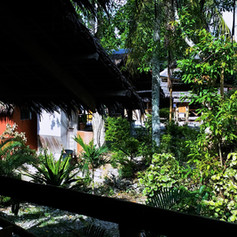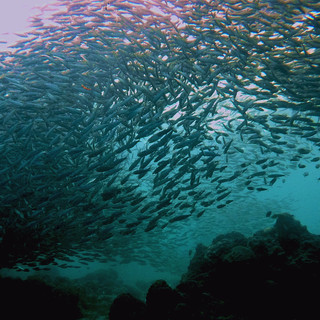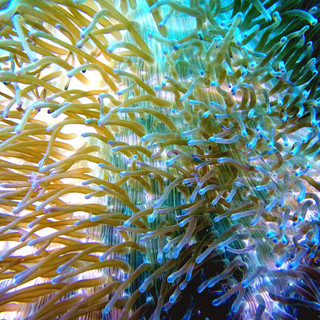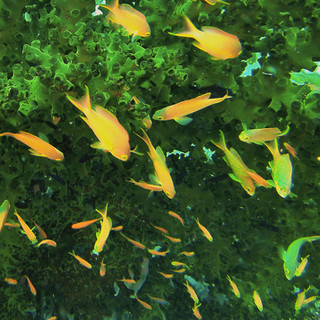We’re Livin’ the Dream
*Aside Subtitle*: We Only Kill the Babies
Wednesday August 10, 2016 Transfer to Moalboal To put it mildly, after the trip to El Nido on the bus, I’m bus-resistant. The bus ride to El Nido was torturous. However, based on the advice given to us by Dennis and Emily on the 2Go Ferry and everything we read the way to go to Moalboal is by bus. The price tag for a car is at least 2000 pesos. The bus is 116 pesos per person. Big difference, so the bus wins. The Ceres Buses are big and comfortable (air-conditioned), and low and behold there is actually Wi-Fi on board! We arrive in Moalboal after an uneventful three hour ride. As usual the trike drivers try all their tricks, trying to grab our luggage before a price is set. We negotiate for two trikes (our luggage is still too much for one).We insist on one of us in each trike with a piece of luggage, despite the best efforts to put both of us in one trike and the luggage in another. *Aside* That’s just not going to happen, sorry.
We booked at Maya’s Native Garden. Our room is large with a double bed and a twin bed, a table and chairs and a big plywood wardrobe that holds everything from our clothes to our suitcases. *Aside* We love having a place to stash our stuff so things aren’t so cluttered! It makes us feel calm. Rebecca unpacks and Tom goes looking for a dive shop, choosing Quo Vadis dive shop, about two minutes walk from our room. Let Tom’s diving and Rebecca’s knee resting begins. The two biggest dive attractions in Moalboal are Pescador Island and the Sardine Run. There is a swarm of Sardines just off shore at the edge of the reef. Perhaps “swarm” doesn’t do this mass of sardines justice there are thousands of them in this pod, massing together in an effort to thwart predators. *Aside* I can’t help wondering if the most dangerous predators are people and fishermen. The ultimate experience is diving in this swarm of sardines. Tom does it the first day of diving. Then just for good measure he does it again on his third day of diving. There is one caveat to this “sardine run” (the name the locals give it): the hordes of constantly defecating sardines have killed the reef where they congregate. Ah well, at least it’s not the tourists this time . . .
Friday, August 13, 2016 Land Day We head out to White Beach. There really isn’t any “beach” in the “tourist” part of Moalboal (this is where all the hotels and dive shops are), particularly beach you can walk. All the businesses have chopped up the shore claiming sections of it for their own. There is a pleasant stretch of sea wall along one part of the one street in “beach-front” Moalboal, but it’s not really beach - at least not the kind you can walk. You don’t see people sunning themselves or swimming there except the occasional stubborn tourist who this MUST be the “beach”. About 5 km up the road is White Beach.
*Aside* Some of the reviews I read commented scathingly that it was not really “white.” Well it was a good deal whiter than everything else we saw. They also complained that it was dirty. There is a lot of debris that washes up at high tide. However, there would have to be a municipal entity with a conscience to take care of the clean-up. Simply that doesn’t exist in the Philippines. Hotels may clean their beach, but “public” beaches have no funds for clean-up. We enter the beach area through a corridor of small retail stores and beach huts and are immediately offered a table and an umbrella on the beach. It’s a bit congested there so we decline. A long stroll down the beach finally gets us away from “civilization.” Unfortunately it’s soft sand and is hard walking according to Rebecca’s knee. So it was not the completely pleasant beach-walking experience she was longing for. Next we take a trike into the “upper” town of Moalboal. This is where the stores are, and yes, the mall. As usual we have a list of things we need to do and buy. Rebecca needs to exchange dollars for pesos. *Aside* I tried to exchange in Cebu where the rate was 4600 or 4700 pesos for $100.00 dollars. When the money changer saw I had twenties the rate went down to 4200 pesos. I kept my dollars and exchanged them in Moalboal for 4620 pesos: no discount for twenties here. Tom needs a new bathing suit and we need a list of miscellaneous toiletries. Then it’s back to the room. Tom takes the next two days to dive as there really isn’t much to do in Moalboal. We really can’t hike the 1.5 km to the waterfall (yeah - that knee problem). But the knee is getting better and Rebecca can actually walk up stairs more like a normal person now, rather than one-stepping it up and down.


On our last day on Moalboal we thought we would visit Lambug Beach, but we woke up lazy and were slow getting started. We picked up Tom’s equipment from Quo Vidas but as he started packing he found a hole all the way through his BCD. We hard to put everything on hold while Tom had to stop to chase a solution: they agreed to fix it for him in Cebu when we returned there. Then just past noon, the skies opened and poured rain. It turned out to be a good thing we didn’t go to the beach. With our bags finally packed, ready to leave the next day, we reflected on our few days in Moalboal. The fact that the main drag of the business section of Moalboal is more than a mile away from our lodging made it less attractive than other places. Lack of walkable beaches was another strike. There was good food to be had, but the restaurants all copy off each other so it ends up feeling generic. So it wasn’t a very enjoyable place. The diving was good, but the hole in the BCD was not! However it was probably the people and the animals we will remember when we remember Moalboal. One day walking to breakfast we see two people walking Labrador Retrievers - one yellow on a leash with his “dad” person, and two more, one black (with his tennis ball in his mouth) and one brown, just trotting off leash along with their “mom” person. Tom held out his hand and the brown Lab immediately stops for a scratch. As Tom starts scratching, the dog sits, then lies down, and then rolls on his back for a belly rub, a big Labrador smile on his puppy dog face! According to our experience in the Philippines, this is the first dog we’ve met that really acts like a normal dog. When you put out a hand to the Pinoy dogs, they shy away, give you a growl, or even a snap. It was awesome to see these obviously well-loved and cared-for dogs. However it makes us feel sad for the rest. *Aside* My idea for a short film is “A Day in the Life of a Pinoy Dog.” I want to choose several dogs, put cameras on their heads and film where they all day. It’s absolutely fascinating to see them trotting down the street with singular focus to who knows where! The beach dogs are especially fun to watch. They pick a place to stretch out and paw away the sand to get to a cool moist layer. As they get hot, they get up dig the hole deeper and lie down again.
One of the things that have made this entire adventure delightful is meeting people - Walter in Manila (we still exchange email); Josh in Puerto Princesa (I follow him on Facebook; Dennis and Emily on the 2Go Ferry (with a standing invitation to visit them in Bohol); and Mayan in Cebu (who has given us the names of all the best restaurants in Cebu). We enjoy spending time with people and hearing their stories. In Moalboal we met Shidon, who joined Tom on a night dive then later joined us for dinner. He told us my favorite story to date: Shidon with a PhD in Statistical Engineering does intensive research on fish ears. Apparently the ear of a fish can reveal its age, diet, location and lots of other amazing facts. *Aside* This is really interesting to me because I never even thought about fish having ears. I mean, I guess everything has ears, but what do fish really have to hear? Maybe divers coming? But divers make bubbles and vibrations. I mean fish don’t talk, do they? Except maybe whales and porpoises. But Shidon reports they have ears and he studies them. He studies the ears of fish to learn about problems and pollution and other kinds of vital information to manage fisheries. Of course to study the fish’s ears, you have to remove them which pretty much ruins the fish for a future life. But the research is valuable and necessary, so to have the least impact possible, they usually only take small fish so that the large fish are left to mate and reproduce. So many baby fish hatch at one time and their survival rate is only about 3% anyway, so this has the least effect on the balance of nature. Shidon’s lab occasionally invites school children to learn about the research. On one such occasion Shidon was explaining how the research was done and what it accomplished when a nine year old girl asked him if he had to kill the fish to study their ears. “Yes,” Shidon replied, “We have to kill them to study them.” “Well, how many have you killed?” asked the girl. “Oh, about fifteen thousand of them,” was Shidon’s off-handed answer. When he saw how distressed the girl was, he added quickly (obviously without thinking), “But don’t worry! We only kill the babies.” The class reviews of school’s visit to the lab were very good, except for the baby fish killer. Yup! This is what makes this trip awesome. And the food. All the different food makes the trip awesome too! Oh! And the diving. The diving is unbelievable. It’s all amazing! Let me just stop now and say this: “We’re livin’ the dream!”







































































